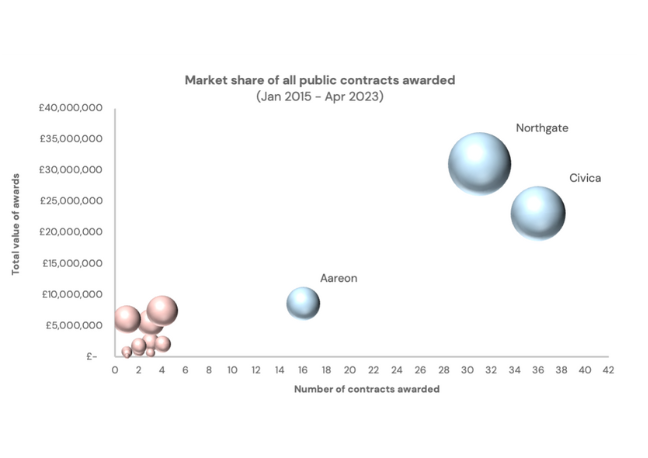Social housing is a vitally important service for millions of people. Social landlords own 4.4 million properties in England alone and roughly 1 in 5 households in England live in social housing. It's a key support to the communities that need it most including low-income families, elderly people and people living with disabilities.
Technology plays an important role in social housing provision, supporting providers (including local authorities and housing associations) to grant access and maintain decent and affordable housing. But all too often, the legacy social housing technology used today is years or even decades old. In the best cases, it's a stumbling block, impacting the efficiency of housing allocation, the maintenance of housing stock and the experience of tenants.
Why are we using social housing technology that doesn’t meet the needs of the people providing and receiving a vital service? And what needs to change to make better technology readily available?
Through a cohort of local authorities led by the London Borough of Redbridge, we examined the systemic factors creating the current problems and looked at central interventions that could shift the market to produce better outcomes for residents.
The state of the market
At a glance, the social housing technology market is thriving. Dozens of companies offer solutions ranging from dedicated end-to-end services for individual aspects of housing to all-encompassing housing management systems that promise to provide a comprehensive solution for providing social housing.

Graph showing share of all public contracts awarded
However, a deeper look at the data reveals that the market, for local authorities at least, is actually dominated by a small handful of players. Together, they account for the sizeable majority of new contracts. Few new contracts go to market and most housing providers are renewing existing systems that don’t meet their needs.
The social housing technology market has a lock-in problem.
Why stay with poor technology?
We wanted to understand why local authorities continue to use systems that don’t meet their needs. Through interviews, desk research and surveys, we found there are three primary factors leading to vendor lock-in:
- technology: inadequate functionality and interoperability push housing providers into using customised systems that are difficult to upgrade or replace
- cultural legacy: risk-averse approaches to procurement and service design mean that business-as-usual approaches are often preferable to taking a chance on something new
- market dynamics: supplier-user relationships have become transactional with a focus on BAU rather than long-term strategic planning
How can we move forward?
Vendor lock-in in the social housing technology market is a complex issue with many contributing factors. There is no single easy solution. But many potential intervention points exist that could have a beneficial impact for both providers and tenants.
We examined various potential actions that could influence the market providers, shifting out of lock-in and into high-quality technology. Interventions around establishing common approaches across the system are the most promising and most workable on a technical, financial, and political level:
- Common contracts/procurement - Address the power imbalance between housing providers and vendors by designing common contracting formats and approaches across all LAs. Instead of focusing on exhaustive lists of BAU requirements, vendors can then focus on innovative ways to add value.
- Common services and processes - Standard processes for managing social housing would help vendors to ensure that products meet user needs without having to conform to inessential variations between buyers. It would also give buyers confidence that basic functionality is in place so that they can focus on added-value differentiators.
- Common data/systems approaches - Standardising data formats/architecture removes a key barrier to upgrading or switching systems through easing data migration and making it easier for suppliers to help LAs to upgrade through simplified and standardised data structures. Improved interoperability would lead to a plug-and-play approach giving LAs/HAs freedom to pick the best systems for individual services/user journeys and making it easier for niche suppliers to enter the market. The 2018 Hackitt report into building safety following the Grenfell fire also highlighted the importance of establishing a “Golden Thread” of building information and the need for a standardised data format for openly accessible and secure information on the design, construction and occupation of high-rise residential blocks.
Moving towards a national housing technology strategy
This project was the first deep examination into the complex challenge that is modernising social housing management to improve outcomes for applicants, residents and staff. There is more to learn before we can pursue a set of interventions with confidence that they will be adopted at scale.
Regardless of which interventions the sector ultimately pursues, we will need alignment and a shared goal. Only with an aim and shared language will we be able to communicate between various stakeholders, build confidence in this new mission and ultimately, align funding across the sector.
The next step is developing a shared narrative that describes these problems, and a campaign created at DLUHC that begins to socialise a view of the highest value standards and processes for standardisation.
This mission narrative should evolve into a national housing technology strategy.
With a shared articulated vision for where we want to get to, the many organisations tasked with improving housing management can start to tip the balance in favour of the healthy market dynamics our residents deserve. We remain agnostic about the ultimate model market interventions will take, but it's clear that standardisation will be a crucial ingredient to make social housing technology work better for everyone involved.

Transforming housing & planning
We help organisations embrace digital infrastructure to streamline delivery and sustainable development, improve services and engage their citizens and customers.
Work with us
Local Digital: uniting for better public services
Bringing together ambitious changemakers to share radically new, standards-based models and tools for local public services
Read moreOur recent insights
Transformation is for everyone. We love sharing our thoughts, approaches, learning and research all gained from the work we do.

Local Digital: uniting for better public services
Bringing together ambitious changemakers to share radically new, standards-based models and tools for local public services
Read more
The role of open data in public service reform
Local Government Partner, David Ayre, shares his thoughts on his time at Budapest Smart City event as a panellist to discuss the role and use of open data and technology in public service reform in the city.
Read more
Understanding the need for low carbon energy systems in UK homes
We’re part of a consortium funded by UK Innovate to look at how local carbon energy systems could decarbonise the supply of electricity in the UK’s homes.
Read more

